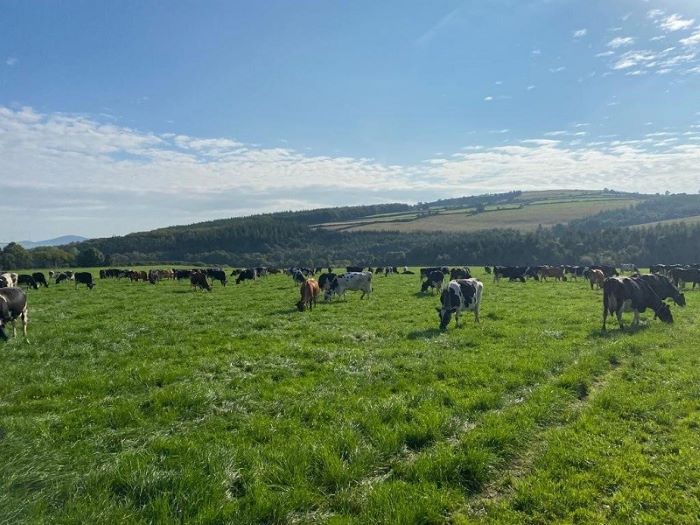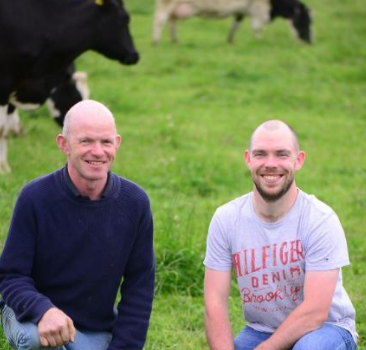23 October 2023
How these dairy farmers more than halved chemical nitrogen applications

As part of Signpost Sustainability Month, dairy farmers John and Brendan Walsh detail the evolution in their farming practices in an effort to improve the sustainability of their farm system.
Joining Emma-Louise Coffey on a recent episode of the Dairy Edge podcast, Brendan explained that, while they have always had an environmental focus on the farm, their urgency in the uptake of new practices has escalated in an effort to help combat climate change.
Some of the practices they have adopted in the last few years include: selective dry cow therapy; the use of protected urea since 2018; a low emission slurry spreader was purchased in 2020; and clover has been a big focus since 2021. In this article, we will focus on the actions that the Walshes have taken to reduce their reliance on chemical nitrogen and their switch to protected urea.
In the last five years, chemical nitrogen (N) usage has changed a lot. In 2020, they used 240kg of N per ha. This was reduced to 115kg N on the grazing block and 109kg N per ha on the whole farm in 2023. A drastic change for the farm which didn’t come about by accident.

Photo caption: John and Brendan Walsh pictured on their farm
In 2016 they bought one pallet of protected urea to try it and since 2021, they have used all protected urea for their chemical N – either 46% or 38% with sulphur. They use some muriate of potash and sulphate of potash, some 18:6:12 is used to balance phosphorous (P) and potassium (K), and 10:10:20 is used for reseeding. The key drivers of the change in chemical N use include:
Step 1. A focus on soil fertility
Overall soil fertility is good on the farm with 62% optimum for lime, P and K. 86% of soils are Index 3 and 4 for P and 73% of soils are Index 3 and 4 for K, with 84% of soils over 6.2 pH.
In the last 3-4 years, John and Brendan have started soil sampling every year. That way they know exactly where they are going to ensure they keep pH, P and K right. This is really important as they have so much clover on the farm and need to be able to maintain it. Fertiliser is not being applied where it’s not needed – avoiding waste.
Lime is applied at reseeding time but fields are topped up also, with 80-100 tonnes applied every year. John likes to see 6.5+ pH for clover and they are constantly topping up to achieve this.
Step 2. Slurry
They are using the dribble bar low emissions equipment for slurry spreading. Slurry is also tested to know its nutrient content. This has helped identify the different quality of slurries on the farm. For example, they have slurry from finishing cattle, which has a high P and K content. They match the slurry quality to either the silage or grass areas on the farm. They can also adjust the rate. It takes more planning, but it is worth it. This has also helped save on chemical fertiliser.
Slurry sampling is costing €50 per sample with Southern Scientific, with a 3-4 weeks turnaround. They get it done in January, so that they have a clear view of the nutrients available to them from slurry before the spreading season.
Step 3. Clover
The incorporation of white clover into grassland swards has been a key driver of reducing chemical N use on the farm. The Walshes have dedicated a lot of time and effort to including clover in reseeds and managing it to ensure persistency. There is 62% of the grazing platform with clover in it. The fertiliser regime for clover is broken into three categories:
- Paddocks with good clover – zero N;
- Paddocks with some clover – 60-80kg (Spring N until late March/April);
- Grass only – 220-230kg N/ha.
Concerns with bloat
John explained that they lost a cow and had cows blown up last autumn, when there was high growth rate following the drought and an abundance of lush, low fibre grass available. The strategies used by Walshes to control bloat are:
- Use a strip wire for 1-2 hours;
- Use straw as a fibre source;
- Have access to bloat oil in the yard ready to use if needed.
Their advice is that if you are nervous of bloat, it’s important to have plan in place. Be prepared for the day when there is a risk. Bloat oil is not used on their farm every day, but they have it there ready beside the parlour if needed.
Tune into the episode of the Dairy Edge podcast below, where John and Brendan provide more details on the sustainability measures being implemented on their farm:
This article forms part of Teagasc Signpost Sustainability Month. For more information on the activities planned over the month of October, click here.
Also read: Planning for the autumn with Shay Ryan
Also read: Edwin Thompson is making strides in increasing the sustainability of his farm
Also read: Taking steps to improve sustainability on a west Cork dairy-beef farm
